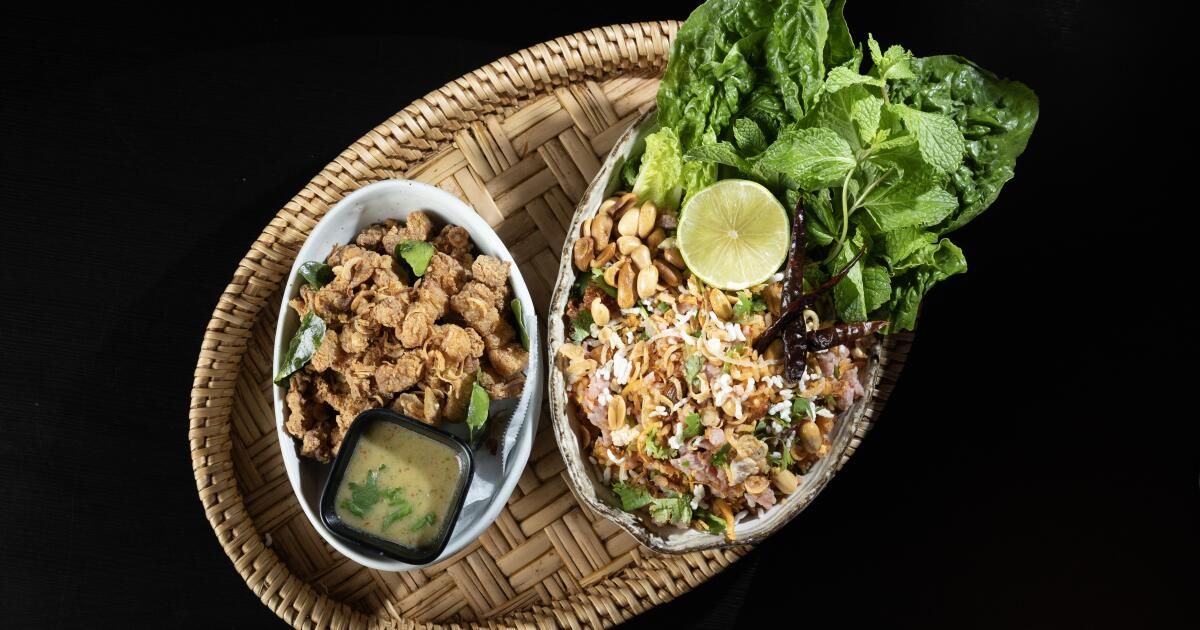“We are going crazy,” says Billie Sayavong. He and his wife, Nokmaniphone, operate Nok's Kitchen, one of the few restaurants in southern California dedicated to Laos cuisine. The Westminster restaurant has appeared repeatedly in the list of the 101 best restaurants in this article.
In the last week, shortly after President Trump announced new rates, Billie saw the increase in the meat and seafood bill by 30%.
Nok's kitchen is largely based on the products imported from all Southeast Asia to make their grill sausages, burning long and crispy rice salad. Even with the president's 90 -day break in tariffs, Sayavongs no longer trust their ability to continue operating the restaurant in an unstable economic climate.
“There is a lot of round trip and the president will make a decision and a change, and our suppliers are not risking,” he says. “They are automatically increasing prices immediately.”
Nok's Kitchen papaya salad and Westminster papaya mixture combo.
(Mariah Tauger / Los Angeles Times)
It is a reality facing restaurants owners throughout the city, who continue to fight with the sequelae of the writers' strike and recent fire disasters. Dozens of companies have already closed since the beginning of the year, with more closures announced in recent weeks.
Tariffs are affecting restaurants that serve kitchens that depend on goods from countries with the highest established tariffs, including the South and Southeast Asia, where the proposed increases vary from 17% to 49%.
But tariffs not only endanger these businesses. They are threatening the diversity of the culinary landscape of southern California, and the heart of what the angels is done is one of the best gastronomic cities in the world.
Taxes are part of President Trump's commercial policy in the United States, aimed at “benefiting the manufacturers of US workers, farmers, ranchers, businessmen and companies.”
The best restaurants in the United States, and a large percentage of the most successful restaurants in Los Angeles, were built on the diversity of our immigrant communities. Approximately one in 10 restaurants in the country serves Mexican food and 12% of all restaurants in the United States serve Asian food, and most are Chinese, Japanese or Thai.
So what does “America First” mean when applied to the restaurant industry? What kitchens are considered Americans and who can decide?
“I just want the commercial war to have ended so that we can survive,” says Shaheen Ghazaly. The chef and owner of Kurrypinch in the happy ones has been in a perpetual state of uncertainty since the new rates were announced. Its restaurant depends largely on the ingredients of Sri Lanka, a country with a proposed 44%rate.
Sri Lanka cinnamon sticks are used in at least 80% of the dishes in the menu. It is what gives Ghazaly's Seyi Sambol, the flavor of caramelized onion, a distinctive cinnamon flavor, subtle and almost citrus.
During the second week of April, shortly after the tariffs were announced, Ghazaly saw the cost of his weekly supermarket order from $ 1,800 to $ 2,600.
The price of two pounds of cinnamon of Sri Lanka increased from $ 37 to $ 49. Cardamon and Clove, two other crucial ingredients for spice mixtures for their curry, were more expensive. The four cases of coconut milk spent every week from Thailand, a country with a 36%proposed rate, increased from $ 28 on the case of $ 42.
The tomatoes built from Mexico went from $ 15 to $ 29 for 25 pounds.
“This is really going to hurt us,” says Ghazaly. “In the restaurant world, the margins are already very thin. And I am quite sure that people will hesitate to enter if I have to increase from $ 5 to $ 6 per plate.”
The idea of losing one of Sri Lanka's few restaurants in the city is disturbing, as well as having to experience food through a more Americanized lens.
Restaurants and chef owners now face a new dilemma: to pass the highest cost of goods to diners with higher prices or reduce costs to rework recipes and replace with cheaper ingredients. For many of these restaurants, there is no cheaper local alternative.
“Making substitutions or making certain ingredients ourselves is not an option,” says Billie. “Our tamarind sauce we do using a certain fermented fish from Thailand. We do not have the bandwidth to go to fish and let it fermente for years. There may be alternatives, but it is not the same. We have a constant menu, and a small change can change the entire dish.”
It is a feeling shared by the restaurants in southern California that depend on the ingredients of the Asian countries that face some of the highest rates. The changing ingredients threaten the integrity of the entire restaurant and their exclusive dishes, many derivatives of family recipes that have developed for decades.

A variety of dishes in Thai Nakorn in Stanton, which includes integral grill, curry and crunchy rice salad.
(Jenn Harris / Los Angeles Times)
Stanton Thai Nakorn restaurant is based on a specific coconut cream in Thailand to make its curry, as well as the rice of Thai jasmine and a long list of herbs. There is a single Thai crab fat, fermented Thai crabs and Thai shrimp paste in the crab papaya salad.
“We have done this for more than 40 years,” says Linda Sreewarom, whose aunt opened the original Thai Nakorn in Orange County in 1984. “Change the recipes completely and try to find different brands of all these things done in the United States is impossible.”
Faceing a tariff of 125% of China's assets, the Bistro Na team in Temple City has to reassess almost all dishes in its menu. The restaurant specializes in Beijing's kitchen, with ingredients imported by local suppliers from all over China. Hawhorn's thine is used to lacquer the firm crispy shrimp in a sweet glaze, sea cucumber and abulon, Jinhua ham, the 10 -year -old Xinhui mandarin peel, the black fungus and a variety of spices.

The estate imported from China is used to make crispy shrimp of Bistro Na's.
(Myung J. Chun / Los Angeles Times)
“In fact, we are exploring options to replace certain imported ingredients with those of more easily available suppliers. However, some ingredients are essential to preserve the authentic flavors of our dishes and cannot be replaced,” says Carol Lin, general manager of the restaurant. “Our costs have already increased and it has become more difficult to operate the business.”
The kitchen is in the process of developing dishes that use more cultivated organic products, such as the new fried eggplant with pinions, garlic and sesame. But the addictive, hot and sweet balance of the dish comes from a mixture of dry Chile from Mexico and China's bar.
Uyên Lê, chef and owner of Bé ù, a small Vietnamese restaurant only to take in Echo Park, has spent the last week trying to balance the cost of perishable items that you now need with non -perishable products that could supply before an increase or shortage of early price.
In mid -March, after four years in the business, Lê made the difficult decision to increase menu prices due to a series of factors that take the financial health of the business, including rentals, supply, staff, insurance and maintenance and replacement of equipment. The restaurant also offers between 30 and 80 meals a day to neighbors in the community.

Bé ù chef-propietary uyên lê, center, and your team prepare free meals for fire and lifeguards evacuated.
(Stephanie Breijo / Los Angeles Times)
“I just increased my prices before these rates, so I am in a retention pattern to discover how much of my products they will rise,” she says. “For many small companies, we end up eating a lot of cost. I am a specific person of the brand because there are many things out there, and over time I have selected brands that I like and that I think they are consistent with my food.”
The Lê inventory comes from a mixture of online vendors and what you buy directly from the Vietnamese markets in Los Angeles and Orange County. During the Pandemia Apogee, Lê put about 150 miles per day in its car, driving to find the lowest price of the restaurant products.
Then there is the issue of sustainability. Buying American, or even locally, may not always be the most sustainable option. Depending on the product, how something occurs can have more environmental impact than how far travel. It is a concept that Lê ', which in a previous life pressed to support green initiatives and green works for a union of electricians, is very conscious.
“For our perishable products it is a bit strange, because to some extent you are trying to be aware of the environment,” she says. “I prefer to buy California avocados due to the shortest time that leads to me and I am supporting local farmers. But they use much more water to grow avocados in California than in Mexico, where it is a region that cultivates avocado.”

The owner of the city of Cambodia de Sopy, Sopy Khut, separates a piece from his famous meat cecina. The dish obtains its hot black pepper flavor with pepper grains from the Kampot region of Cambodia.
(Angelis Ron / for the Times)
The obtaining of pepper grains exclusively from the Kampot region of Cambodia helps that Sophy's Cambodian city be a culinary destination in Long Beach. The owner Sophy Khut Marina slabs of beef cecina in a heavy garlic sauce with pepper grains, appreciated by their unique strength and aroma. It is a dish that is worth traveling, and that helped keep the restaurant in business during the last two decades.
The cost of khut to buy pepper grains is $ 18 per pound, not including shipping or taxes.
“She is really hitting me,” she says. “I worry a lot and I feel that I am having an anxiety attack.”
Like all the restorers I talked to, Khut says that he will exhaust all the resources available before increasing prices, even for a fraction. But altering ingredients such as its precious Kampot pepper grains will never be an option.
I can think of hundreds of similar examples, entire immigrant dishes and kitchens that depend on ingredients that are not available in the United States or too expensive to produce locally. With the threat of rates that are still coming, and the restaurants and diners who already feel the squeeze, we should all ask ourselves the same question. Without immigrant food culture, what is American food?












